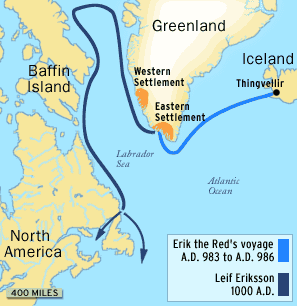VIKINGS
This blog is about vikings, this blog has pictures in every post, you tube videos for your enjoyment :P
Total Pageviews
Tuesday, June 11, 2013
Vikings Discovering America
A Viking called Bjarni Herjolfsson discovered America by accident
in the year 985. He saw an unknown land, after his ship was blown off
course on the way from Iceland to Greenland. In 1001, Leif Ericsson, the
son of Eric the Red, sailed west to find this new land.
Leif and his men were the first Europeans known to have landed in America. They spent the winter in a place they named "Vinland" (Wine-land). It was in Newfoundland, Canada. Soon afterwards, Thorfinn Karlsefni led a small group of Viking families to settle in the new land. But after fights with the local Native American people, the Vikings gave up their settlement.
son of Eric the Red, sailed west to find this new land.
Leif and his men were the first Europeans known to have landed in America. They spent the winter in a place they named "Vinland" (Wine-land). It was in Newfoundland, Canada. Soon afterwards, Thorfinn Karlsefni led a small group of Viking families to settle in the new land. But after fights with the local Native American people, the Vikings gave up their settlement.
Monday, June 10, 2013
Viking Children
Babies were given little Thor's
hammer charms, to protect them from evil spirits and sickness. A boy usually took his father's name too - so Eric, son of Karl, became Eric Karlsson. Girls often took the same name as their mother or grandmother.
Viking children did not go to school. They helped their parents at work, and learned Viking history, religion and law from spoken stories and songs, not from books. By 15 or 16 they were adult. It was common for a girl's father to choose her husband.
hammer charms, to protect them from evil spirits and sickness. A boy usually took his father's name too - so Eric, son of Karl, became Eric Karlsson. Girls often took the same name as their mother or grandmother.
Viking children did not go to school. They helped their parents at work, and learned Viking history, religion and law from spoken stories and songs, not from books. By 15 or 16 they were adult. It was common for a girl's father to choose her husband.
What did the men and woman do?
Most Viking men were all round handy men, but some had special skills.
There were boat builders, for example and potters, leather workers and
black smiths. Most Viking men knew how to handle a boat. And most could fight
if they had to, to protect the family or to support their chieftain(leader).
Women baked bread. They did spinning and weaving to turn sheep wool into cloth. They looked after the children, made the family's clothes and cooked the two meals a day most families ate. On the farm, women milked the cows and made cheese.
Women baked bread. They did spinning and weaving to turn sheep wool into cloth. They looked after the children, made the family's clothes and cooked the two meals a day most families ate. On the farm, women milked the cows and made cheese.
Thursday, May 30, 2013
Vikings Weapons
The laws of the late Viking period show that all free men were expected
to own weapons, and magnates were expected to provide them for their
men. The main offensive weapons was the spear, sword and battle-axe,
although bows and arrows and other missiles were also used. Weapons were
carried not just for battle, but also as symbols of their owners'
status and wealth. They were therefore often finely decorated with
inlays, twisted wire and other adornments in silver, copper and bronze.The spear was the commonest weapon with an iron blade on a
wooden shaft, often of ash and 2 to 3m in length. It was used for both
thrusting and throwing. The blades varied in shape from broad leaf
shapes to long spikes. Skilled spearsmen are said to have been able to
throw two spears at once using both hands, or even to catch a spear in
flight and hurl it back with deadly effect.Swords were very costly to make, and a sign of high status.
The blades were usually double-edged and up to 90cm, or a little over,
in length, but early single-edged sabres are also known. They were worn
in leather-bound wooden scabbards. Early blades were pattern-welded, a
technique in which strips of wrought iron and mild steel were twisted
and forged together, with the addition of a hardened edge. Later blades
of homogeneous steel, imported probably from the Rhineland, bore inlaid
makers' marks and inscriptions.Viking
craftsmen often added their own elaborately decorated hilts, and many
swords were given names, such as Leg-biter and Gold-hilt.Long-handled battle-axes might be used instead of swords,
particularly in open combat. The famed, double-handed broad axe is a
late development, typical of the late 10th and 11th centuries. But as
the owner could not hold a shield at the same time, he would take cover
behind the front line of warriors, rushing out at the right moment to
hew down the enemy.
Wednesday, May 29, 2013
Subscribe to:
Comments (Atom)



